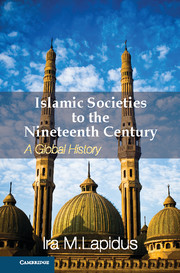Book contents
- Frontmatter
- Contents
- List of Illustrations
- List of Figures
- List of Maps
- List of Tables
- Preface
- Acknowledgments
- Acknowledgments to the first edition of A History of Islamic Societies
- Acknowledgments to the second edition of A History of Islamic Societies
- Publisher's Preface
- Introduction to Islamic Societies
- Part I The Beginnings of Islamic Civilizations
- Part II From Islamic Community to Islamic Society
- Part III The Global Expansion of Islam from the Seventh to the Nineteenth Centuries
- Glossary
- Bibliography
- Annotated Bibliography from A History of Islamic Societies, 2nd Edition
- Index
Introduction to Islamic Societies
Published online by Cambridge University Press: 05 February 2013
- Frontmatter
- Contents
- List of Illustrations
- List of Figures
- List of Maps
- List of Tables
- Preface
- Acknowledgments
- Acknowledgments to the first edition of A History of Islamic Societies
- Acknowledgments to the second edition of A History of Islamic Societies
- Publisher's Preface
- Introduction to Islamic Societies
- Part I The Beginnings of Islamic Civilizations
- Part II From Islamic Community to Islamic Society
- Part III The Global Expansion of Islam from the Seventh to the Nineteenth Centuries
- Glossary
- Bibliography
- Annotated Bibliography from A History of Islamic Societies, 2nd Edition
- Index
Summary
The history of Islamic societies to the nineteenth century will be presented in two dimensions: one historical, an effort to account for the formation of Islamic societies and their change over time; the other analytic and comparative, which attempts to understand the variations among them. Three methodological and historical assumptions underlie these approaches. The first is that the history of whole societies may be presented in terms of their institutional systems. An institution, whether an empire, a mode of economic exchange, a family, or a religious practice, is an activity carried out in a patterned relationship with other persons as defined and legitimized in the mental world of the participants. An institution encompasses at once an activity, a pattern of social relations, and a set of mental constructs.
The second assumption is that the history of Islamic societies may be told in terms of four basic types of institutions: familial, including tribal, ethnic, and other small-scale community groups; economic, the organization of production and distribution of material goods; cultural or religious, the concepts of ultimate values and human goals and the collectivities built on such commitments; and political, the organization of conflict resolution, defense, and domination.
- Type
- Chapter
- Information
- Islamic Societies to the Nineteenth CenturyA Global History, pp. 1 - 4Publisher: Cambridge University PressPrint publication year: 2012



